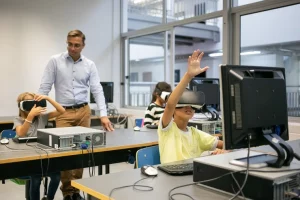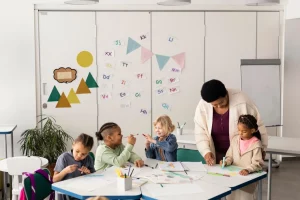10 Tools of Building Skills Through Play
In today’s fast-paced, digital-driven world, the traditional methods of education are increasingly being challenged. Students are growing up surrounded by technology, which has dramatically influenced their learning preferences and capabilities. This shift has given rise to a powerful educational strategy known as gamification. By integrating game mechanics like points, badges and leaderboards into the learning environment, educators can foster engagement, motivation and enhance their learning outcomes.
What is Gamification in Education?
Gamification is the application of game-design elements and principles in non-game contexts. In education, this involves incorporating components such as points, badges, leaderboards and rewards into the learning process. The goal is to make learning more engaging and enjoyable, improving student outcomes. Educators can transform the traditional classroom into an interactive, immersive experience by tapping into the intrinsic motivations that games naturally elicit.

The benefits of Gamification in Education
Enhanced Engagement and Motivation
One of the most significant advantages of gamification is its ability to boost student engagement. Traditional education methods often fail to capture the interest of students, leading to disengagement and lacklustre performance. Gamification, however, introduces an element of fun and excitement that can make learning more appealing. When students are actively involved and motivated, they are more likely to retain information and perform better academically
Recent study: In a study conducted by the University of Colorado, researchers found that students who participated in gamified learning activities showed a 14% increase in knowledge retention and a 20% increase in engagement compared to those who did not.
Development of Critical Skills
Gamification can help students develop a wide range of skills beyond academic knowledge. These include critical thinking, problem-solving, collaboration, and communication. For example, multiplayer games often require teamwork and strategy, encouraging students to work together and think critically to achieve common goals.
Recent study: The educational game, Minecraft: Education Edition, promotes creativity, problem-solving, and collaboration. Teachers can use it to create projects that require students to work together to build structures, solve puzzles, and complete quests.
Personalized Learning Experience
Every student learns at their own pace and has unique strengths and weaknesses. Gamified learning environments can be tailored to individual needs, providing personalized challenges and support. This customization ensures that students remain challenged without becoming overwhelmed, fostering a more inclusive and supportive learning environment.
Recent study: Khan Academy uses gamification elements such as badges and progress tracking to personalize learning. Students can earn badges for mastering topics and track their progress through a series of levels.

Case Studies: Successful Gamification in Education
1. Navio
A digital platform that accompanies Macmillan’s English language courses for young learners. It uses game-based activities to reward learners and make learning more engaging.
https://www.macmillanenglish.com/navio
2. Macmillan Education eReader
The App gives access to all the animations, videos and other interactive activities that are provided as part of the digital learning resources in the eReader. The desired content can be easily downloaded and used offline as and when needed.
The App provides both teachers and learners with a simple and mobile solution to access curriculum-based study.
https://lms-cdn-prod-eu1.macmillan.education/ereaderapps/index.html
3. Macmillan Education Everywhere
You can now take your learning and teaching material with you anywhere with the Macmillan Education Everywhere app.
The app gives access to all the book content, animations, videos and other interactive activities that are provided as part of your Macmillan Education course. Teachers and students can add their own notes, bookmark pages to find again later, and make annotations on the book page. Content can be easily downloaded and used offline when needed.
https://www.macmillaneducationeverywhere.com/
4. ClassDojo
ClassDojo is an app that encourages positive behaviour in classrooms through a points system. Teachers award points for good behaviour, participation, and teamwork. This not only motivates students but also creates a classroom community where students can see their progress and work toward collective goals. The real-time feedback fosters engagement and accountability.
https://www.classdojo.com/download/
5. Kahoot!
Kahoot! is an interactive quiz platform that gamifies assessment. Teachers create quizzes that students answer in real time on their devices. The competitive element, along with instant feedback, makes learning fun and engaging. Schools across the globe use Kahoot! to review material, assess understanding, and encourage participation, resulting in higher engagement levels.
https://kahoot.com/
6. Minecraft: Education Edition
Many educators have adopted Minecraft: Education Edition to promote creative problem-solving and collaboration. This game allows students to build and explore virtual worlds while completing educational challenges. For instance, students can recreate historical sites, learn coding, or collaborate on environmental projects, making complex subjects accessible and engaging.
https://education.minecraft.net/
7. Duolingo
Duolingo, a language learning app, uses gamification principles like levels, rewards, and daily challenges to motivate learners. Schools have integrated Duolingo into their language curricula, allowing students to learn at their own pace while fostering healthy competition through leaderboards and achievements.
https://www.duolingo.com/
8. Zombies, Run!
In a unique approach to physical education, some schools have used Zombies, Run!, a mobile game that combines running with an immersive storyline. Students must complete missions by running in the real world, promoting physical activity while engaging in a narrative adventure, making exercise more appealing.
https://zrx.app/
9. PlayPosit
PlayPosit is a platform that allows teachers to turn videos into interactive lessons by adding quizzes and discussion prompts. This gamified approach encourages active viewing and ensures that students engage with the content deeply. Schools utilizing PlayPosit have reported improved comprehension and retention rates.
https://go.playposit.com/
10. The Leaderboard Effect
At an elementary school in California, educators introduced a leaderboard system for various subjects. Students earned points for completing assignments, participating in class, and helping peers. This friendly competition encouraged students to push themselves academically, resulting in improved overall performance.
Challenges of Gamification in Education
Balancing Fun and Learning
One of the primary challenges of gamification is striking the right balance between fun and educational value. While it is important to make learning enjoyable, the educational content must remain the focus. Educators need to ensure that gamified activities are designed to achieve specific learning outcomes rather than merely entertaining students.

Ensuring Inclusivity
Not all students are equally motivated by game-based learning. Some may prefer traditional methods, while others might struggle with the competitive aspects of gamification. To address this, educators must create a variety of gamified activities that cater to different learning styles and preferences, ensuring that all students can benefit from the approach.
Macmillan Education: Gamification and Interactive Learning
Macmillan Education employs gamification in several ways to enhance interactive learning:
1. Game-Based Learning: Incorporating games that challenge students to solve problems, complete tasks, or compete with peers, making learning more engaging and enjoyable.
2. Points and Badges: Rewarding students with points, badges, or certificates for completing activities, which motivates them to participate actively and track their progress.
3. Interactive Quizzes: Using quizzes that provide immediate feedback and incorporate game-like elements, such as time limits or leaderboards, to encourage friendly competition.
4. Storytelling: Designing learning experiences around narratives or characters, making lessons more relatable and memorable.
5. Simulations: Creating realistic scenarios that allow students to practice skills in a safe environment, promoting critical thinking and problem-solving.
6. Collaboration: Facilitating team-based challenges that encourage collaboration and social interaction among students.

